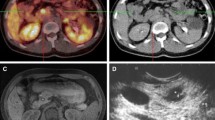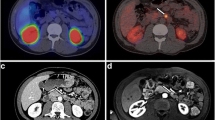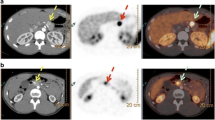Abstract
Multiple endocrine neoplasia type 1 (MEN1) is a hereditary syndrome predisposing to many endocrine and neuroendocrine tumors (NET). Conventional imaging (CI) cannot provide satisfactory results for all the different types of MEN1-related tumors. Objective of this prospective observational study was to evaluate the role of 68Ga-DOTATATE PET/CT in MEN1 compared to CI. Diagnostic performance of 68Ga-DOTATATE PET/CT for the detection of NET was evaluated as well as the prognostic role of SUVmax. Eighteen patients with genetically confirmed MEN1 were evaluated by 68Ga-DOTATATE PET/CT, endoscopic ultrasounds, multidetector-row computed tomography, magnetic resonance imaging, and hormone/markers serum measurements. Four MEN1-related tumor sites (pancreas, pituitary, parathyroids, adrenals) were considered. Sensitivity and specificity of 68Ga-DOTATATE PET/CT for the detection of NET were calculated. There was 68Ga-DOTATATE PET/CT uptake in 11/11 patients with pancreatic lesions, in 9/12 with pituitary adenoma, in 5/15 with parathyroid enlargements, and in 5/7 with adrenal lesions. 68Ga-DOTATATE PET/CT showed sensitivity and specificity of 100 and 100 % in pancreas, 75 and 83 % in pituitary, 28 and 100 % in parathyroids, and 62.5 and 100 % in adrenals, respectively. Compared with CI, no significant difference in sensitivity for pancreas, pituitary, and adrenals was found, while CI had a better sensitivity for parathyroids (p = 0.002). On the ROC analysis, progression of pancreatic lesions was significantly associated to SUVmax <12.3 (p < 0.05). 68Ga-DOTATATE PET/CT is greatly helpful in the work-up of MEN1 providing a panoramic view of MEN1-related lesions. There is also a prognostic role of 68Ga-PET in patients with MEN1-pancreatic lesions.

Similar content being viewed by others
References
R.V. Thakker, P.J. Newey, G.V. Walls, J. Bilezikian, H. Dralle, P.R. Ebeling, S. Melmed, A. Sakurai, F. Tonelli, M.L. Brandi, Endocrine society: clinical practice guidelines for multiple endocrine neoplasia type 1 (MEN1). J. Clin. Endocrinol. Metab. 97, 2990–3011 (2012)
V. Ramundo, F. Milone, R. Severino, S. Savastano, C. Di Somma, L. Vuolo, L. De Luca, G. Lombardi, A. Colao, A. Faggiano, Clinical and prognostic implications of the genetic diagnosis of hereditary NET syndromes in asymptomatic patients. Horm. Metab. Res. 43, 794–800 (2011)
M. Imamura, Recent standardization of treatment strategy for pancreatic neuroendocrine tumors. World J. Gastroenterol. 16, 4519–4525 (2010)
R.B. Lewis, G.E. Lattin Jr, E. Paal, Pancreatic endocrine tumors: radiologic-clinicopathologic correlation. Radiographics 30, 1445–1464 (2010)
E.P. Krenning, D.J. Kwekkeboom, W.H. Bakker, W.A. Breeman, P.P. Kooij, H.Y. Oei, M. van Hagen, P.T. Postema, M. de Jong, J.C. Reubi et al., Somatostatin receptor scintigraphy with [111In-DTPA-D-Phe1]- and [123I-Tyr3]-octreotide: the Rotterdam experience with more than 1000 patients. Eur. J. Nucl. Med. 20, 716–731 (1993)
M. Hofmann, H. Maecke, R. Börner, E. Weckesser, P. Schöffski, L. Oei, J. Schumacher, M. Henze, A. Heppeler, J. Meyer, H. Knapp, Biokinetics and imaging with the somatostatin receptor PET radioligand (68)Ga-DOTATOC: preliminary data. Eur. J. Nucl. Med. 28, 1751–1757 (2001)
I. Kayani, J.B. Bomanji, A. Groves, G. Conway, S. Gacinovic, T. Win, J. Dickson, M. Caplin, P.J. Ell, Functional imaging of neuroendocrine tumors with combined PET/CT using 68Ga-DOTATATE (DOTA-DPhe1, Tyr3-octreotate) and 18F-FDG. Cancer 112, 2447–2455 (2008)
I. Virgolini, V. Ambrosini, J.B. Bomanji, R.P. Baum, S. Fanti, M. Gabriel, N.D. Papathanasiou, G. Pepe, W. Oyen, C. De Cristoforo, A. Chiti, Procedure guidelines for PET/CT tumor imaging with 68Ga-DOTA-conjugated peptides: 68Ga-DOTA-TOC, 68Ga-DOTA-NOC, 68Ga-DOTA-TATE. Eur. J. Nucl. Med. Mol. Imaging 37, 2004–2010 (2010)
A. Al-Nahhas, Z. Win, T. Szyszko, A. Singh, C. Nanni, S. Fanti, D. Rubello, Gallium-68 PET: a new frontier in receptor cancer imaging. Anticancer Res. 27, 4087–4094 (2007)
M. Ginj, J. Chen, M.A. Walter, V. Eltschinger, J.C. Reubi, H.R. Maecke, Preclinical evaluation of new and highly potent analogues of octreotide for predictive imaging and targeted radiotherapy. Clin. Cancer. Res. 11, 1136–1145 (2005)
D. Wild, J.S. Schmitt, M. Ginj, H.R. Mäcke, B.F. Bernard, E. Krenning, M. De Jong, S. Wenger, J.C. Reubi, DOTA-NOC, a high-affinity ligand of somatostatin receptor subtypes 2, 3 and 5 for labelling with various radiometals. Eur. J. Nucl. Med. Mol. Imaging 30, 1338–1347 (2003)
V. Froeling, F. Elgeti, M.H. Maurer, C. Scheurig-Muenkler, A. Beck, T.J. Kroencke, U.F. Pape, B. Hamm, W. Brenner, N.F. Schreiter, Impact of Ga-68 DOTATOC PET/CT on the diagnosis and treatment of patients with multiple endocrine neoplasia. Ann. Nucl. Med. 26, 738–743 (2012)
M.S. Hofman, G. Kong, O.C. Neels, P. Eu, E. Hong, R.J. Hicks, High management impact of Ga-68 DOTATATE (GaTate) PET/CT for imaging neuroendocrine and other somatostatin expressing tumours. J. Med. Imaging. Radiat. Oncol. 56, 40–47 (2012)
D.J. Kwekkeboom, P.P. Kooij, W.H. Bakker, H.R. Mäcke, E.P. Krenning, Comparison of 111In-DOTA-Tyr3-octreotide and 111In-DTPA-octreotide in the same patients: biodistribution, kinetics, organ and tumor uptake. J. Nucl. Med. 40, 762–767 (1999)
C. Wehrmann, S. Senftleben, C. Zachert, D. Müller, R.P. Baum, Results of individual patient dosimetry in peptide receptor radionuclide therapy with 177Lu DOTA-TATE and 177Lu DOTA-NOC. Cancer Biother. Radiopharm. 22, 406–416 (2007)
S. Kumar Gupta, S. Singla, N.A. Damle, K. Agarwal, C. Bal, Diagnosis of Men-I syndrome on (68)Ga-DOTANOC PET-CT and role of peptide receptor radionuclide therapy with (177)Lu-DOTATATE. Int. J Endocrinol. Metab. 10, 629–633 (2012)
M.A. Lewis, G.B. Thompson, W.F. Young Jr, Preoperative assessment of the pancreas in multiple endocrine neoplasia type 1. World J. Surg. 36, 1375–1381 (2012)
A. McLean, Endoscopic ultrasound in the detection of pancreatic islet cell tumors. Cancer Imaging 4, 84–91 (2004)
S. Philips, S.N. Shah, R. Vikram, S. Verma, A.K. Shanbhogue, S.R. Prasad, Pancreatic endocrine neoplasms: a current update on genetics and imaging. Br. J. Radiol. 85, 682–696 (2012)
C. Barbe, A. Murat, B. Dupas, P. Ruszniewski, A. Tabarin, M.P. Vullierme, A. Penfornis, V. Rohmer, E. Baudin, M. Le Rhun, D. Gaye, C. Marcus, G. Cadiot, Groupe d’étude des Tumeurs Endocrines (GTE), Magnetic resonance imaging versus endoscopic ultrasonography for the detection of pancreatic tumors in multiple endocrine neoplasia type 1. Dig. Liver. Dis. 44, 228–234 (2012)
L. Camera, S. Paoletta, C. Mollica, F. Milone, V. Napolitano, L. De Luca, A. Faggiano, A. Colao, M. Salvatore, Screening of pancreaticoduodenal endocrine tumors in patients with MEN 1: multidetector-row computed tomography vs. endoscopic ultrasound. Radiol. Med. 116, 595–606 (2011)
R. Gao, H. Isoda, T. Tanaka, S. Inagawa, H. Takeda, Y. Takehara, S. Isogai, H. Sakahara, Dynamic gadolinium-enhanced MR imaging of pituitary adenomas: usefulness of sequential sagittal and coronal plane images. Eur. J. Radiol. 39, 139–146 (2001)
N. Naswa, C.J. Das, P. Sharma, S. Karunanithi, C. Bal, R. Kumar, Ectopic pituitary adenoma with empty sella in the setting of MEN-1 syndrome: detection with 68Ga-DOTANOC PET/CT. Jpn. J. Radiol. 30, 783–786 (2012)
S. Piciucchi, D. Barone, G. Gavelli, A. Dubini, D. Oboldi, F. Matteuci, Primary hyperparathyroidism: imaging to pathology. J. Clin. Imaging Sci. 2, 59 (2012)
A. Faggiano, L.B. Tavares, L. Tauchmanova, F. Milone, G. Mansueto, V. Ramundo, M.L. De Caro, G. Lombardi, G. De Rosa, A. Colao, Effect of treatment with depot somatostatin analogue octreotide on primary hyperparathyroidism (PHP) in multiple endocrine neoplasia type 1 (MEN1) patients. Clin. Endocrinol. 69, 756–762 (2008)
Author information
Authors and Affiliations
Corresponding authors
Ethics declarations
Conflict of interest
The authors declare that they have no conflict of interest.
Additional information
Secondo Lastoria and Francesca Marciello have equally contributed to the article.
On the behalf of the Multidisciplinary Group for Neuroendocrine Tumors of Naples.
Rights and permissions
About this article
Cite this article
Lastoria, S., Marciello, F., Faggiano, A. et al. Role of 68Ga-DOTATATE PET/CT in patients with multiple endocrine neoplasia type 1 (MEN1). Endocrine 52, 488–494 (2016). https://doi.org/10.1007/s12020-015-0702-y
Received:
Accepted:
Published:
Issue Date:
DOI: https://doi.org/10.1007/s12020-015-0702-y




